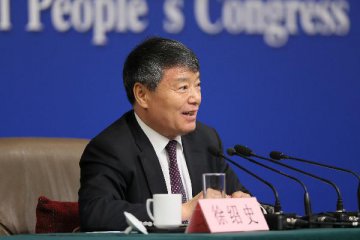
A U.S. expert on Tuesday refuted the claim that China's economy heads to a hard-landing as Beijing looks to services to rev up slowing economic growth.
Fears of a hard-landing in China and sharp depreciation of its currency are widely cited as a cause of global market volatility in 2016, but "these pessimistic narratives focus excessively on China's industrial sector," where growth has been moderating for six years, said Nicholas Lardy, a senior fellow at the Peterson Institute for International Economics and a leading expert on China's economy, in a research analysis of reality check on China.
"Little noticed is the fact that services have become the major driver of China's economic growth and now account for over half of the GDP," Lardy said. He added that the ultra-bearish view is not consistent with the strong growth of wages, household disposable income, airline and rail passenger traffic, and other indicators of strong service sector growth in China. A number of factors suggest that services such as wholesale and retail trade, restaurants and hotels, health, education, finance and information technology will continue to drive China's economic growth, according to the expert.
As China's working age population is actually shrinking, Lardy said, wages tend to continue rising, bolstering the growth of household income and private consumption expenditures. "Wages have been rapidly rising in China for some time, so much so that household disposable income for several years has risen faster than the GDP," he said. Lardy said the substantial progress the government has made in building out the social safety net would also help reduce the precautionary demand for saving and make Chinese consumers be willing to spend more. As services production is more labor intensive than industrial production, the rising share of services in the GDP can also lead to stronger growth of urban employment than the earlier pattern of development, contributing to the further growth of household income, he said.
Lardy said the moderation in China's industrial growth over the last five years largely reflects a slowing in property investment. "Growth of property investment declined from 33 percent in 2010 to 1 percent last year, dragging down the growth of demand for steel, cement and other building materials." Given the large overhang of unsold inventory, Lardy believed property investment is likely to shrink in absolute terms this year, slowing industrial growth further, but the service sector growth is likely to hold up relatively well and "limit the deceleration of GDP growth this year to less than a percentage point." "The strength of its service sector will likely allow China to avoid a hard economic landing in the next couple of years," Lardy said, hoping the leadership will use this opportunity to deleverage its highly indebted firms and implement the economic reform agenda that the Communist Party of China outlined more than two years ago. "That is the most realistic basis for sustaining growth and moving China ultimately into the ranks of the high-income countries," he said.
China's economy, facing notable downward pressures amid a difficult economic overhaul, grew 6.9 percent year-on-year in 2015, the slowest annual expansion in a quarter of a century but still enviable by global standards. China's economic growth rate target has been set at 6.5 percent to 7 percent in 2016, with an average annual growth rate of at least 6.5 percent through 2020, Premier Li Keqiang said Saturday when presenting the government work report to an annual parliamentary session. This year's target is aligned with China's goal of completing the building of a moderately prosperous society in all respects, and takes into consideration the need to advance structural reform, Li said.
























Latest comments